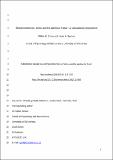Files in this item
Steroid hormones, stress and the adolescent brain : a comparative perspective
Item metadata
| dc.contributor.author | Brown, Gillian Ruth | |
| dc.contributor.author | Spencer, Karen Anne | |
| dc.date.accessioned | 2015-06-18T15:10:02Z | |
| dc.date.available | 2015-06-18T15:10:02Z | |
| dc.date.issued | 2013-09-26 | |
| dc.identifier | 39717361 | |
| dc.identifier | 2a9cb8c8-6501-4c46-9f95-bdd8e2e7e595 | |
| dc.identifier | 000323874800012 | |
| dc.identifier | 84881549369 | |
| dc.identifier.citation | Brown , G R & Spencer , K A 2013 , ' Steroid hormones, stress and the adolescent brain : a comparative perspective ' , Neuroscience , vol. 249 , pp. 115-128 . https://doi.org/10.1016/j.neuroscience.2012.12.016 | en |
| dc.identifier.issn | 0306-4522 | |
| dc.identifier.other | ORCID: /0000-0002-0675-0780/work/60195758 | |
| dc.identifier.other | ORCID: /0000-0002-2851-9379/work/78205010 | |
| dc.identifier.uri | https://hdl.handle.net/10023/6847 | |
| dc.description.abstract | Steroid hormones, including those produced by the gonads and the adrenal glands, are known to influence brain development during sensitive periods of life. Until recently, most brain organisation was assumed to take place during early stages of development, with relatively little neurogenesis or brain re-organisation during later stages. However, an increasing body of research has shown that the developing brain is also sensitive to steroid hormone exposure during adolescence (broadly defined as the period from nutritional independence to sexual maturity). In this review, we examine how steroid hormones that are produced by the gonads and adrenal glands vary across the lifespan in a range of mammalian and bird species, and we summarise the evidence that steroid hormone exposure influences behavioural and brain development during early stages of life and during adolescence in these two taxonomic groups. Taking a cross-species, comparative perspective reveals that the effects of early exposure to steroid hormones depend upon the stage of development at birth or hatching, as measured along the altricial–precocial dimension. We then review the evidence that exposure to stress during adolescence impacts upon the developing neuroendocrine systems, the brain and behaviour. Current research suggests that the effects of adolescent stress vary depending upon the sex of the individual and type of stressor, and the effects of stress could involve several neural systems, including the serotonergic and dopaminergic systems. Experience of stressors during adolescence could also influence brain development via the close interactions between the stress hormone and gonadal hormone axes. While sensitivity of the brain to steroid hormones during early life and adolescence potentially leaves the developing organism vulnerable to external adversities, developmental plasticity also provides an opportunity for the developing organism to respond to current circumstances and for behavioural responses to influence the future life history of the individual. | |
| dc.format.extent | 520568 | |
| dc.language.iso | eng | |
| dc.relation.ispartof | Neuroscience | en |
| dc.subject | Adrenal | en |
| dc.subject | Gonadal | en |
| dc.subject | Behaviour | en |
| dc.subject | Devleopment | en |
| dc.subject | Mammals | en |
| dc.subject | Birds | en |
| dc.subject | QH301 Biology | en |
| dc.subject.lcc | QH301 | en |
| dc.title | Steroid hormones, stress and the adolescent brain : a comparative perspective | en |
| dc.type | Journal article | en |
| dc.contributor.institution | University of St Andrews. School of Psychology and Neuroscience | en |
| dc.identifier.doi | 10.1016/j.neuroscience.2012.12.016 | |
| dc.description.status | Peer reviewed | en |
This item appears in the following Collection(s)
Items in the St Andrews Research Repository are protected by copyright, with all rights reserved, unless otherwise indicated.

